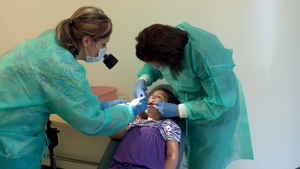CDHC Roles

Role in the healthcare team/community
CDHCs are trained to:
- Work under a dentist's supervision, and within the confines of state dental practice acts. They function in clinics, schools, and other public health settings with people of similar ethnic and cultural backgrounds
- Collect information to assist dentists in triaging patients
- Address social, environmental, and health literacy issues
- Provide dental health education and help people develop goals to enhance their oral health
- Coordinate care in accordance with a dentist's instructions
- Help patients navigate the complexities of the health care system
- Provide limited clinical services, including:
- Screenings
- Fluoride treatments
- Placements of sealants
- Coronal polishing
- Radiographs
How do they work with patient populations?
CDHCs perform community outreach and directly provide dental education and preventative dental services. They also assist in the coordination of dental care,navigation of the healthcare system, and patient tracking and follow-up. This includes helping obtain healthcare appointments and transportation, as well as, other support when necessary. CDHCs map out the social and health support networks within a community to insure that its members also know how to access available resources. CDHCs utilize culturally relevant methods to target specific populations with the use of individual behavior change strategies that can be used to improve an individual’s oral health status.
Who do they work with?
CDHCs have been trained to work with persons from their respective communities. Specific examples include the CDHC’s work with diabetic populations, pregnant mothers and pediatric populations as well.
Where do they work?
CDHCs work under the supervision of a dentist at a clinic (Federally Qualified Clinics, IHS clinics, tribal clinics or private offices). CDHCs may target underserved populations encountered at WIC centers, Head Start and Early Head Start Centers, mental health organizations, healthy baby initiatives, hospices, substance abuse clinics, senior citizen centers, cancer societies, community health fairs, schools, and other community events. In addition, CDHCs may target patients of existing health clinics encountered at medical visits for inclusion in dental services visits.

